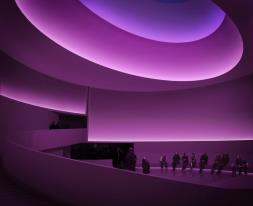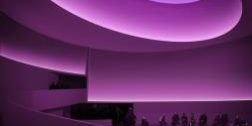 The unique art of James Turrell infuses space with light. The artist makes entire rooms, museums, and even craters his canvases by transforming large areas into viewing experiences that manipulate how observers perceive their environments when natural and artificial lights alternate.
The unique art of James Turrell infuses space with light. The artist makes entire rooms, museums, and even craters his canvases by transforming large areas into viewing experiences that manipulate how observers perceive their environments when natural and artificial lights alternate.
Turrell has been experimenting with light since 1966. He seems to be fascinated by the way light impacts how an individual understands space, perception, and even color. In relation, the American artist says this about the miraculous correlation:
“We teach the color wheel, but we really should speak about the light frequencies of each eye, and then the context of vision in which they reach the eye, because that’s how we perceive.”
This post explores James Turrell’s approach to art by briefly exploring how light manipulates space, how light changes perception, and the necessary relationship between light and art. At the conclusion, there are resources to inspire further exploration into this intricate subject.
Light Manipulates Space
Most people understand that light affects the way we see color and perceive the world around us. But is it comprehensible that light can manipulate space regardless of physical material? Turrell sets out to prove that a limited and definite space can be created without manmade parameters, like those set up with wood beams, steel rods, or concrete. This is because light itself creates space. When light stops so does vision. And when vision stops, so do the confines of a space. Turrell calls this, “using the eyes to penetrate the space.”
Light Changes Perception
This offers a little help in grasping how the absence or presence of light changes our perception of space. To further explain, Turrell points up. He says this earthly phenomenon is best understood by looking up to the atmosphere we experience every day.
In the light of the sun, it is impossible to see stars. However, as the sun goes down, an individual’s penetration of vision goes out, and the stars become evident again. Stars, which are constant in placement, are only visible lights when our eyes are able to perceive them as such. This can only happen when sunlight is mostly absent from our view.
Light and Art: A Relationship
Artists have always looked at the world with curious fascination and longing to use light as a means of creating space. This is why, when artists began using lights, shading, and perspective within paintings, the world marveled at how lifelike the images became. The reality is, like Turrell, artist have always seen what does not exist because they have brilliance all their own.
To read more about the effects of life on art, follow the works and study of James Turrell. Here are some helpful links to begin this exploration:
- http://www.pbs.org/wnet/egg/215/turrell/interview_content_1.html
- http://www.pbs.org/art21/artists/james-turrell
- http://style.time.com/2013/02/21/spring-preview-the-latest-style-news/
- http://en.wikipedia.org/wiki/James_Turrell
If you enjoyed this Segmation blog post, you are sure to love:
-The Importance of Color Vision and Art
https://www.segmation.com/2011/11/30/paint-by-number-color-vision-effects-art-appreciation/
– Are Your Colors What They Seem to be?
https://www.segmation.com/2010/10/02/are-your-colors-what-they-seem-to-be/
– The Benefits of Making Art Outside
https://www.segmation.com/2010/05/22/the-benefits-of-making-art-outside/
Be an Artist in 2 minutes with Segmation SegPlay® PC (see more details here)
Join us on FacebookSegPlay® Mobile iTunes now available for iPhone and iPad







love turrell, his works are beautiful.